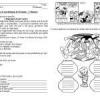To better understand the mass measurements, it is necessary to understand the difference between mass and weight. The mass is the amount of matter that a body has, it is constant anywhere on the planet and outside of it.
Weight, on the other hand, is the force with which the body is attracted (gravity) to Earth, varying according to where the person is located. An example of this is the weight of man on Earth, and the value of weight on the Moon.
see more
Students from Rio de Janeiro will compete for medals at the Olympics…
The Institute of Mathematics is open for registration for the Olympics…
The mass of man on Earth or on the Moon has the same value, however, the weight is six times greater on Earth than on the Moon. This can be explained by the fact that Earth's gravity is six times greater than the gravity of the Moon.
despite the standard unit of mass in the international system of units is the kilogram, it is the gram that is used in practice as the main unit of measurement. Larger measures of mass are called multiples.
Those for grams are: the dekagram (dag), the hectogram (hg) and the kilogram (kg). The smallest measures of mass are called submultiples, being those of the gram: decigram (dg), centigram (cg) and milligram (mg).
The gram conversions are:
1 kilogram (kg) contains 1000 grams (g)
1 hectogram (hg) contains 100 grams (g)
1 decagram (dg) contains 10 grams (g)
The value of one gram is equal to:
10 dekagrams (dg)
100 decigrams (cg)
1000 milligrams (mg)
As seen earlier, the kilogram is the standard unit of mass in the international system of units. Thus, the kilogram, also known as “kg” is the mass of 1 dm³ of distilled water at a temperature of 4ºC.
As for the use of this unit of measurement, it can be used to account for the mass of household products such as meat, rice, corn, fruits, vegetables and legumes. However, for such products it is also possible to use gram.
A ton is a multiple of a gram, with a ton equaling 1,000,000 g or 1,000 kg. This is a unit often used to indicate large masses, such as the weight of a plane or truck load.
See too: Polyhedrons – What they are, concave, convex, Plato's, regular

